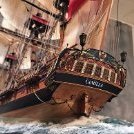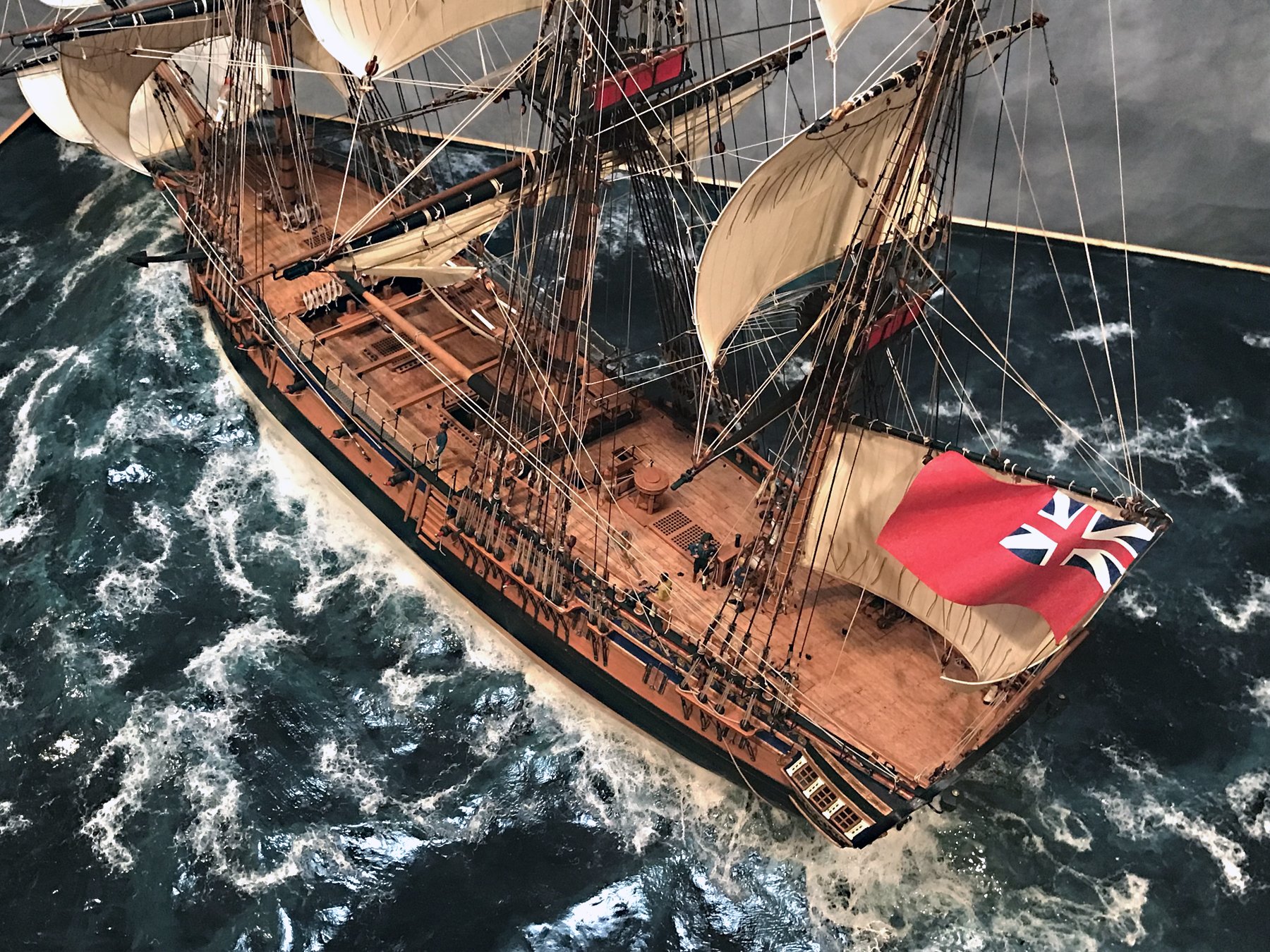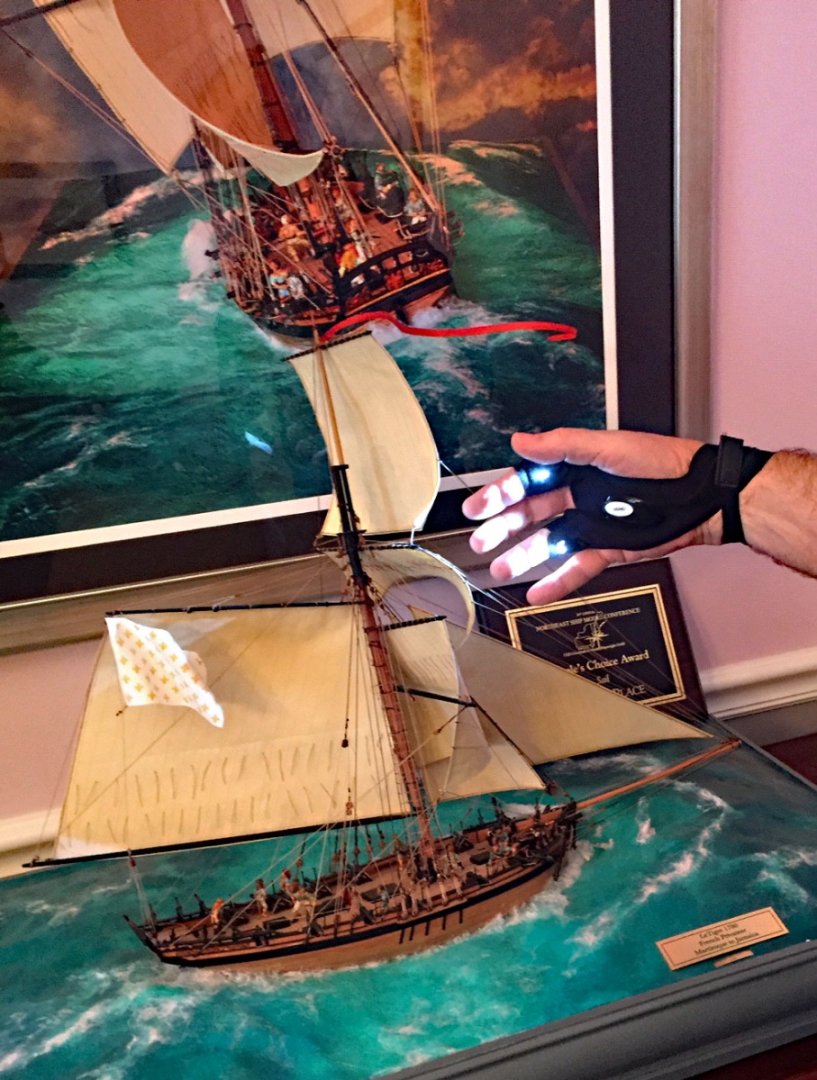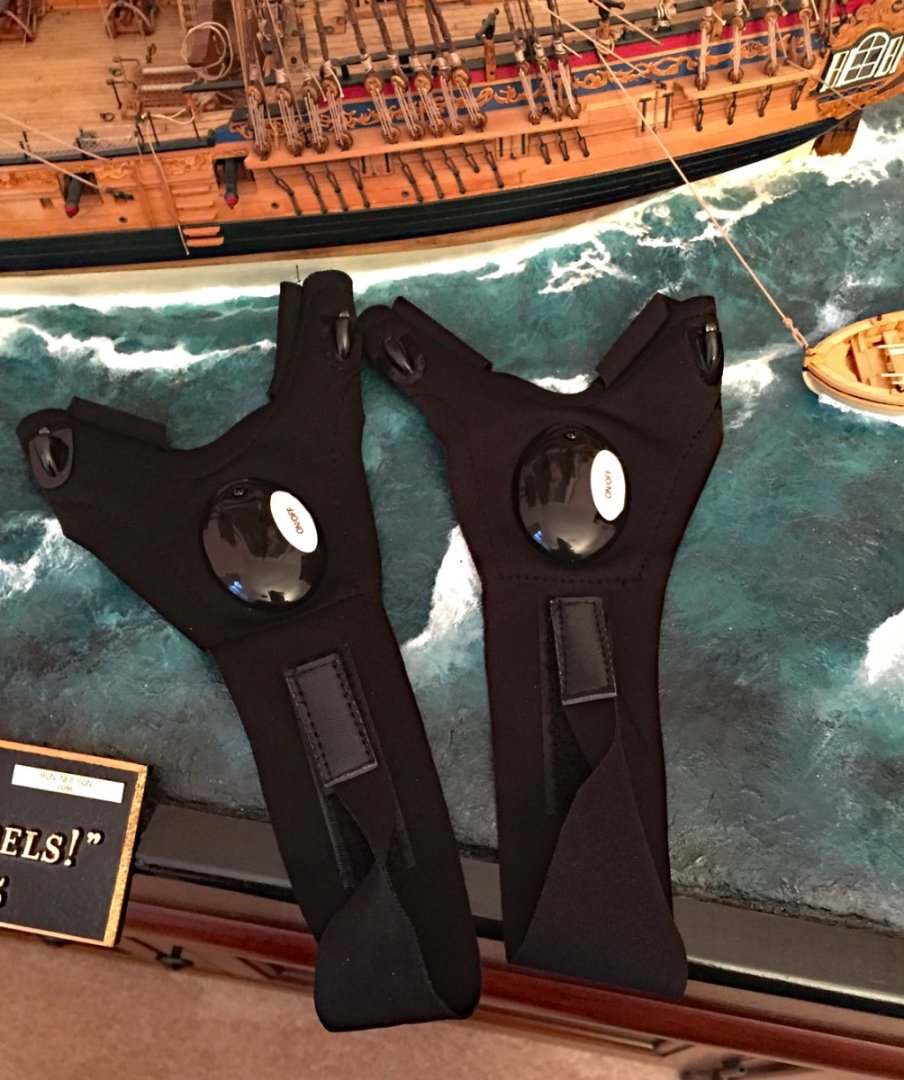-
Posts
1,588 -
Joined
-
Last visited
Content Type
Profiles
Forums
Gallery
Events
Everything posted by hollowneck
-
Thank you, Glenn. Yes. There is an extensive photo gallery on my forum "home page." Why it's listed the 4th down entry for my model albums I have no idea....but the Camilla photos are posted there. Like everyone else, these holidays were crazy busy for me and I may have overlooked formally posting info on my log here for folks that they could go to my gallery albums; my apologies for this. Thank You, Chris. You (& Jim) are the one's responsible for creating such a fine kit. Your excellent work allowed me to get crazy with additional details and then get super-excited to put her into a roiling sea!
- 542 replies
-
- Sphinx
- Vanguard Models
-
(and 3 more)
Tagged with:
-
Same model here, but bought it in 2020...I always keep the bowl as full of paint as I can during a session and with the lid on.
- 488 replies
-
- Indefatigable
- Vanguard Models
-
(and 1 more)
Tagged with:
-
Interesting. I use an Iwata airbrush (dual-action), top feed. So far, so good. Perhaps we use different models, vintages? This said, I only airbrush minimally and only on large surface areas where I want as much color consistency as possible - like on my silk span sails; I've used my airbrush to touch-up from previous Liquitex rattle can spraying where there are visual "holes". Airbrushing is a staple in the plastic modeling world for good reason. For wooden model ships, not so much - also for good reason.
- 488 replies
-
- Indefatigable
- Vanguard Models
-
(and 1 more)
Tagged with:
-
Vallejo Model Air paint=100 per cent! Saves having to disassemble your airbrush every 15 minutes.
- 488 replies
-
- Indefatigable
- Vanguard Models
-
(and 1 more)
Tagged with:
-
It’s looking really good, Tom. Have you assembled some of the unique rigging components like turnbuckles and wire rope?
- 200 replies
-
- Whaling Bark
- Charles W Morgan
-
(and 1 more)
Tagged with:
-
Welcome to the forum. This is the right (and BEST) place to learn about model ship building. Post all the questions you'd like; you'll get plenty of helpful advice - and encouragement. As long as you can acquire some basic tolls like @rcmdrvr has recommended, you can build that styrene model and then step over to a wooden kit with a handful of a few more tools - and then you could do some repairs on the legacy model from your grandmother. I've got a question for you: how did you learn about this free forum? THANKS!!
-
Thanks James, understood. I hope @VTHokiEE will finalize and make his app/module available to MSW. He's generously done this compilation for me and it is still a work in progress - as he's noted. I would hope that he can make his software available to others here.
- 542 replies
-
- Sphinx
- Vanguard Models
-
(and 3 more)
Tagged with:
-

backing up a log
hollowneck replied to Knocklouder's topic in Using the MSW forum - **NO MODELING CONTENT IN THIS SUB-FORUM**
…looks like I might need to invest in an Adobe Acrobat Pro application…🤨😁😳 Perhaps a good time to “cook” my 650 page pdf into a PowerPoint one, another item on my 2023 hobby punch list. For the moment I’m shooting lot'sa photos for a final gallery post for ... HMS Camilla Leaving Spithead, bearing West, So’west for North America August, 1776 -
I have successfully opened @VTHokiEE's compiled Build Log for my HMS Camilla. The file is 259 MB with a total of 648 pdf pages conforming to a "normal" print-friendly format of 8.5" X 11." Outstanding. I haven't perused all 648 pages, but I intend over the next few days to double-check the fidelity; on a brief first pass (approx. 100 pages) I noticed only one graphics page (pg. 14) didn't successfully load; every text page appears intact. I graciously Thank @VTHokiEE you for the significant software work to make this happen. I can recommend to @James H that this works very well. Where we go from here is not clear to me but I do suggest the obvious: do contact @James H and see how he can implement this tool on the site.
- 542 replies
-
- Sphinx
- Vanguard Models
-
(and 3 more)
Tagged with:
-

backing up a log
hollowneck replied to Knocklouder's topic in Using the MSW forum - **NO MODELING CONTENT IN THIS SUB-FORUM**
I have successfully opened @VTHokiEE's compiled Build Log for my HMS Camilla. For others reading this post, your file is 259 MB with a total of 648 pdf pages conforming to a "normal" print-friendly format of 8.5" X 11." Outstanding. I haven't perused all 648 pages, but I intend to over the next few days to double-check the fidelity; on a brief first pass (approx. 100 pages) I noticed only one graphics page (pg. 14) didn't successfully load; every text page appears intact. Thank you for your work to make this happen. I can recommend to @James H that this works very well. Where we go from here is not clear to me but I do suggest the obvious: do contact @James H and see how he can implement this tool on the site. -

Trademark News
hollowneck replied to hollowneck's topic in NAUTICAL RESEARCH GUILD - News & Information
UPDATE: MSW members will now note that there is a Marcas Registrada - ® - (registered trademark) adjacent to the MSW logo and the words "Model Ship World" on the home page header. Rule of Law Progress. -

backing up a log
hollowneck replied to Knocklouder's topic in Using the MSW forum - **NO MODELING CONTENT IN THIS SUB-FORUM**
@Knocklouder, this is not contentious and James isn't going to "boot" any member on the basis of posting legitimate investigations on computer questions. Saving a complete Build Log with a more simplified method than the one I described in detail here would be a GIANT and very usable feature for MSW if it could be implemented. Let's see where this legitimate query ends-up. Despite my gripe about Adobe's business practices, If there was an easier (and faster) method to save a Build Log to a single, compiled PDF file, then I might- just might- pop for an Adobe PDF Pro converter to have full access to my log in a workable, native presentation format like PowerPoint or Keynote. -

backing up a log
hollowneck replied to Knocklouder's topic in Using the MSW forum - **NO MODELING CONTENT IN THIS SUB-FORUM**
I have just completed a Build Log and I am interested in archiving it offline onto my computer. As a test, I exported the first page of my Build Log to a PDF ( I am, like @James H on a MAC - with a Safari browser). The export took a couple minutes (there's a LOT of data in just a single "page" of the Build Log), and the single first page of my log was diced-up into six (6) vertical graphic files that totaled approximately 15 MB. It eventually opened (with some substantial lag time) - just fine. From beginning to end, my Build Log is 17 pages long. Assuming a compiled PDF file of my log will be an average of 15MB, my complete Build Log downloaded to multiple PDF files would total something in the area of 250MB - in 17 separate files. This isn't an unmanageable file size, but it is quite large for a PDF and will take a rather long time to scroll through one's log - depending upon how much RAM you have in your computer (my system has 32GB). An issue that concerns me with my test is that this PDF Export routine froze my browser. After saving the PDF, I re-started my browser, no problem. However, I attempted to export my PDF test file to a PowerPoint format (so that it can be annotated and opened by either a MAC or PC) and I ran into the Adobe pitch to buy a $250 single year license. Were I still operating my marketing business, I'd already have this requisite PDF Pro program expensed as a necessary yearly overhead. I MAY have need to do this file extraction and saving exercise - oh, let's just say - once, maybe twice a year. Would you want to spend $250 for a program that you'll use once or twice in a year and then spend another $250 the next year to efficiently save your next Build Log? I do hope that @VTHokiEE has a workable script that can be run on a MAC OS to get a workaround to this restrictive situation. -

backing up a log
hollowneck replied to Knocklouder's topic in Using the MSW forum - **NO MODELING CONTENT IN THIS SUB-FORUM**
I believe you meant to say you CAN GET IT OFF THE GROUND.... Yes? If so, I suggest you contact James (by PM) with your "Bash" script for proof-of-service. -
Thank You all kindly @mtaylor, @Blue Ensign, @BobG & @DelF
- 542 replies
-
- Sphinx
- Vanguard Models
-
(and 3 more)
Tagged with:
-

Trademark News
hollowneck replied to hollowneck's topic in NAUTICAL RESEARCH GUILD - News & Information
Mark - It's been approximately one year from when the NRG filed the paperwork with the feds; it took awhile, but the response time was nothing unusual... -

Trademark News
hollowneck replied to hollowneck's topic in NAUTICAL RESEARCH GUILD - News & Information
This big black arrow button is the 💣! Thanks & a Peaceful and Healthy New Year back at’cha! -
Wow. This tool looks absolutely Medieval. 2,400 copper plates with 9,600 indents made by this tool one at a time? It does involve torture! James, you're a better jeweler than I...😂
- 488 replies
-
- Indefatigable
- Vanguard Models
-
(and 1 more)
Tagged with:
-
It's Official: the Nautical Research Guild's Model Ship World name and the MSW Logo are now trademarked by the U.S.Patent & Trademark Office Members may have noticed the "TM" adjacent to the name and logo in the home page masthead.
-
I am not familiar with “beading tool;” can you (or another MSW member) post a photo of the tool? thanks!
- 488 replies
-
- Indefatigable
- Vanguard Models
-
(and 1 more)
Tagged with:
-
Something for Everyone Topic, or how I learned to love how Santa's mind works. Special "Rigging Gloves" with two bright LED lights positioned at the base of the forefinger and the ring finger (or pinky, to suit). ..and the best part? They come in pairs, left & right, batteries included and installed. These SpaceAge gloves will come in handy for those who no longer want to hold a small flashlight between their teeth whilst rigging (or doing anything else where these awesome gloves might come in handy). Endorsed by thieves with a specialty in lock picking and by poker players who can still have a game when there are rolling blackouts. Essential Wear/WARE for 2023. If there's sufficient interest here, I'll contact Santa and see if his workers are not out on strike...
- 542 replies
-
- Sphinx
- Vanguard Models
-
(and 3 more)
Tagged with:
About us
Modelshipworld - Advancing Ship Modeling through Research
SSL Secured
Your security is important for us so this Website is SSL-Secured
NRG Mailing Address
Nautical Research Guild
237 South Lincoln Street
Westmont IL, 60559-1917
Model Ship World ® and the MSW logo are Registered Trademarks, and belong to the Nautical Research Guild (United States Patent and Trademark Office: No. 6,929,264 & No. 6,929,274, registered Dec. 20, 2022)
Helpful Links
About the NRG
If you enjoy building ship models that are historically accurate as well as beautiful, then The Nautical Research Guild (NRG) is just right for you.
The Guild is a non-profit educational organization whose mission is to “Advance Ship Modeling Through Research”. We provide support to our members in their efforts to raise the quality of their model ships.
The Nautical Research Guild has published our world-renowned quarterly magazine, The Nautical Research Journal, since 1955. The pages of the Journal are full of articles by accomplished ship modelers who show you how they create those exquisite details on their models, and by maritime historians who show you the correct details to build. The Journal is available in both print and digital editions. Go to the NRG web site (www.thenrg.org) to download a complimentary digital copy of the Journal. The NRG also publishes plan sets, books and compilations of back issues of the Journal and the former Ships in Scale and Model Ship Builder magazines.







